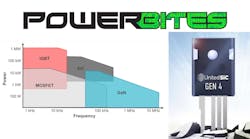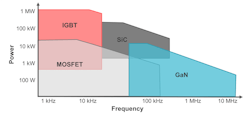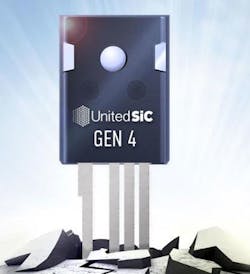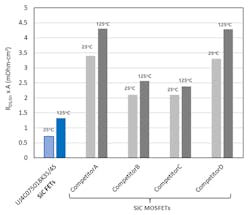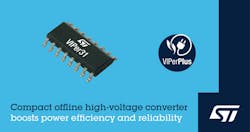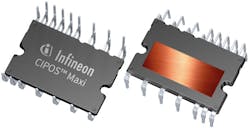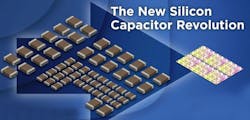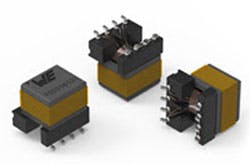>> Electronic Design Resources
.. >> Library: Article Series
.. .. >> Article Series: PowerBites
How to Make the Most of GaN FETs in High-Frequency Auto Apps
Texas Instruments just published an informative monograph on how gallium-nitride (GaN) FETs and other wide-bandgap (WBG) semiconductors are helping accelerate the electrification of the global automotive fleet. The article focuses on making on-board chargers (OBCs) more compact, efficient, and powerful; much of the information presented is relevant to designing propulsion components as well. While some of the stats and technical analysis they provide are pretty obvious, many others, such as their discussion on the design challenges involved with switched-mode power converters operating at higher frequencies, are new and quite insightful. Click here to read the full article.
Smart, Cool-Running 750-V SiC FETs May be Silicon-Slayers: A PowerBites Mini-Review
Since their arrival, silicon-carbide (SiC) transistors have offered superior performance. However, cost, usability, and other unconventional characteristics have slowed their adoption in most high-power applications currently owned by silicon-based MOSFETs and IGBTs.
Those hindrances may become a thing of the past with the introduction of UnitedSiC's fourth generation (Gen 4) of SiC FETs. They offer significant advances in operating voltage, efficiency, and other performance factors, while functioning as nearly plug-and-play replacements for their silicon counterparts. The new generation's 750-V rating provides the additional design margin needed for reliable use in electric vehicles and other applications with a 400- or 500-V battery/bus voltage.
Like all of its earlier devices, the new series is based on the company's unique device structure that reduces output capacitance and RDS(on). This leads to higher operating frequencies and greater efficiency for improved performance in high-frequency, soft-switched resonant converter topologies such as LLC or PSFB.
They are also co-packaged with a silicon driver IC that eliminates the need for SiC's unconventional gate biasing, allowing them to be driven just like silicon MOSFETs. This is a potential game-changer because it allows designers to quickly bring greater efficiency and performance to their proven, well-characterized products and technologies. The company says that these improvements are intended to accelerate the adoption of WBG power devices in automotive drivetrains as well as industrial charging, telecom rectifiers, and data-center power-factor-correction (PFC) dc-dc conversion, as well as renewable-energy and energy-storage systems.
Despite their increased voltage rating, UnitedSiC's Gen 4 devices still use the company's advanced cell geometry to maximize power density and minimize their RDS(on) per unit area, resulting in what the company believes to be the industry’s lowest losses on any device.
The devices’ high current ratings are also made possible by an advanced sintered die-attach technology that provides significantly better thermal performance than conventional bonding techniques. The figure below shows the new 750-V specific on-resistance versus 650-V-rated SiC competitors, offering substantially lower conduction losses across the full temperature range.
As mentioned earlier, all Gen 4 devices can be safely driven with the standard 0- to 12- or 15-V gate-drive voltages used by conventional Si MOSFETs, allowing them to be operated from all typical Si IGBT, Si MOSFET, and SiC MOSFET drive voltages. The drive electronics also provide a solid threshold noise margin and a built-in ESD gate protection clamp.
Along with low on-resistance, these new SiC FETs offer improved efficiency in both hard- and soft-switched circuits. In hard-switched circuits such as totem-pole PFC or standard two-level inverters, the low on-resistance per unit area and low output capacitance along with the near-zero stored charge in the low-voltage Si MOSFET combine to offer superior reverse-recovery charge (Qrr) and low Eoss/Qoss. The devices exhibit a superior and robust integral diode with low voltage drop VF (<1.75 V).
Pricing (1000-up, FOB USA) for the new 750-V Gen 4 SiC FETs range from $3.57 for the UJ4C075060K3S to $7.20 for the UJ4C075018K4S. All devices are available from authorized distributors.
Additional details are available from the company's refreshingly informative press release, which can be accessed by clicking here.
Highly Integrated Offline Converter Saves Space, Energy, and BOM Costs
STMicroelectronics's VIPer31 is a compact, high-voltage converter IC that enables robust, power-efficient, cost-effective solutions for switched-mode power supplies (SMPS) used in large or small home appliances, air conditioning, smart-home or -building automation, lighting, metering, and motor-control applications. Supplies based on the highly integrated controller deliver excellent reliability and meet global eco-design requirements, while saving on bill-of-materials (BOM) costs.
The VIPer31 integrates a jittered pulse-width-modulation (PWM) controller with an 800-V avalanche-rugged MOSFET power section, high-voltage startup circuit, sense FET, error amplifier for direct feedback, and internal supply without auxiliary winding. The device features a clamp-less design.
Configured for 30-, 60-, or 132-kHz operation, the VIPer31 is optimized for commonly used offline ac-dc converter topologies, including isolated and non-isolated flyback, buck, and buck-boost converters. It accepts a wide range of supply voltages (4.5 to 30 V). Also, 24-V dc drain startup voltage eliminates the need for additional external circuitry and allows for an ultra-wide ac input-voltage range. Other features include over/undervoltage protection, soft-start, short-circuit protection, pulse-skipping protection, and thermal shutdown.
The VIPer31, in production now, is housed in a SO16N package and priced from $0.46 for orders of 1000 pieces. For more information, go to http://www.st.com/viper31-pr.
100-V GaN Half-Bridge Eval Board Makes Exploring WBG Designs Easy
A new 100-V high-speed, half-bridge evaluation board (GS-EVB-HB-61008P-ON), developed by GaN Systems in collaboration with ON Semiconductor, is intended to help power electronics designers easily evaluate GaN for new and existing 48-V market applications. This includes non-isolated step-down converters, non-isolated step-up converters, and half- and full-bridge converters.
The board includes an ON Semi NCP51810 GaN driver and two GaN Systems GS61008P E-mode GaN power transistors; they’re connected in a high-side, low-side configuration with all necessary drive circuitry. It provides the utmost flexibility of GaN transistor and driver combinations and can be applied in any topology that requires a high-side/low-side FET combination. When connected into an existing power supply, it can replace HS/LS drives and MOSFETs. It also offers configurable dead-time control and driver enable/disable functions. For additional information, click here.
World's First 1200-V Transfer-Molded SiC IPM Handles up to 4.8 kW
The CIPOS Maxi IPM IM828 series of 1200-V transfer-molded SiC integrated power modules (IPMs) is the capstone of Infineon Technologies’ year-long roll-out of SiC solutions. The modules integrate an improved six-channel, 1200-V silicon-on-insulator (SOI) gate driver and six CoolSiC MOSFETs in a DIP 36x23D housing to increase system reliability, optimize PCB size, and reduce system costs.
The compact inverter solution offers excellent thermal conduction and a wide range of switching speeds, suiting it for three-phase ac motors and permanent-magnet motors in variable-speed drives. Applications include industrial motor drives, pumps drives, and active filters for heating, ventilation, and air conditioning (HVAC).
The rugged six-channel SOI gate driver of the SiC IPM provides built-in dead time to prevent damage from transients. It also offers undervoltage lockout (UVLO) at all channels and overcurrent shutdown protection functions. The IPM's protection features include an independent UL-certified temperature thermistor. The low-side emitter pins can be accessed for phase-current monitoring, making the device easy to control.
The CIPOS Maxi IM828 series can be ordered now. It comprises a 20-A IM828-XCC for power ratings of up to 4.8 kW. More information is available at www.infineon.com/IPM.
Monolithic Multi-Capacitor Arrays Boost Performance with 80% Space Savings
Empower Semiconductor introduced a unique family of monolithic multi-capacitor arrays that offer dramatic improvements in size, performance, and reliability over previously available components. The devices are fabricated using a technology known as E-CAP, which allows for groups of capacitors in various values and sizes to be integrated onto a single die. Arrays of capacitors fabricated in this manner offer superior stability with no dc or ac bias derating, no temperature derating, and no significant effects of aging. This tiny die format allows for footprints that are 80% smaller than equivalent multi-layer ceramic capacitor (MLCC)-based solutions.
According to Empower, these performance benefits enable higher power efficiency in voltage filtering for SoCs/CPUs during load transients in IoT, wearables, mobile, and processors, where size, performance, and flexibility are essential. E-CAP is available in configurations up to 8.4 µF.
High-Voltage Superjunction MOSFET Family Targets TV, LED Lighting, Fast Chargers
Eight new 700- and 800-V series high-voltage superjunction (SJ) MOSFETs from MagnaChip Semiconductor featuring higher performance and efficiency are optimized for TV, LED lighting, and fast charger applications. The new 800-V SJ MOSFETs are designed for applications that have high or unstable input voltages and include an embedded Zener diode between gate and source to avoid damage from an external surge or electrostatic discharge. The devices also maintain a low total gate charge, reduced by 30% over previous versions for improved power efficiency and reduced switching loss.
Visit www.magnachip.com for more information.
Compact SMT Transformers Optimized to Drive SiC MOSFETs
The WE-AGDT family of transformers, developed by Würth Elektronik, are optimized to support the gate control of SiC MOSFETs used in a series of reference designs for power supplies. Each of the six compact transformers is housed in an EP7 SMT package. They feature a wide input voltage range (9 to 36 V), a high saturation current (4.5 A), very low leakage inductance, and a very low capacitance of 6.8 pF between the windings that provides very high common-mode transient immunity (CMTI).
Thanks to their two separate secondary windings, they allow both bipolar (+15 V, -4 V) and unipolar (+15 V to +20 V, 0 V) output voltages. The input voltage of 9 to 36 V achieves a maximum output power of 3 to 6 W. WE-AGDT transformers are optimized for SiC applications, but are also suitable for optimally controlling IGBT and power MOSFETs. And, given a suitable dc-dc converter, they can even be used for high-voltage GaN FETs.
WE-AGDT is available from stock without a minimum order quantity. On request, free samples are made available to developers. Würth Elektronik's reference design for a compact, galvanically isolated dc-dc converter for SiC MOSFET gate drivers is available at www.we-online.com/RD001.
>> Electronic Design Resources
.. >> Library: Article Series
.. .. >> Article Series: PowerBites
